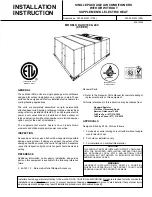
96
RT-SVX34F-EN
Maintenance
Fan Belt Adjustment
The Supply Fan belts must be inspected periodically to
assure proper unit operation.
Replacement is necessary if the belts appear frayed or
worn. Units with dual belts require a matched set of belts
to ensure equal belt length. When installing new belts, do
not stretch them over the sheaves; instead, loosen the
adjustable motor-mounting base.
Once the new belts are installed, adjust the belt tension
using a Browning or Gates tension gauge (or equivalent)
illustrated in
Figure 60
.
1.
To determine the appropriate belt deflection:
a. Measure the center-to-center distance, in inches,
between the fan sheave and the motor sheave.
b. Divide the distance measured in Step 1a by 64; the
resulting value represents the amount of belt
deflection for the proper belt tension.
2. Set the large O-ring on the belt tension gauge at the
deflection value determined in Step 1b.
3. Set the small O-ring at zero on the force scale of the
gauge.
4. Place the large end of the gauge on the belt at the
center of the belt span. Depress the gauge plunger until
the large O-ring is even with the of the second belt or
even with a straightedge placed across the sheaves.
5. Remove the tension gauge from the belt. Notice that
the small O-ring now indicates a value other than zero
on the force scale. This value represents the force (in
pounds) required to deflect the belt(s) the proper
distance when properly adjusted.
6. Compare the force scale reading in step 5 with the
appropriate “force” value in
Figure 61, p. 96
. If the
force reading is outside of the listed range for the type
of belts used, either readjust the belt tension or contact
a qualified service representative.
Note:
The actual belt deflection force must not exceed the
maximum value shown in
Figure 61, p. 96
.
7.
Recheck the new belt's tension at least twice during the
first 2 to 3 days of operation. Readjust the belt tension
as necessary to correct for any stretching that may
have occurred. Until the new belts are “run in”, the belt
tension will decrease rapidly as they stretch.
Figure 60.
Typical belt tension gauge
Figure 61.
Belt deflection
















































